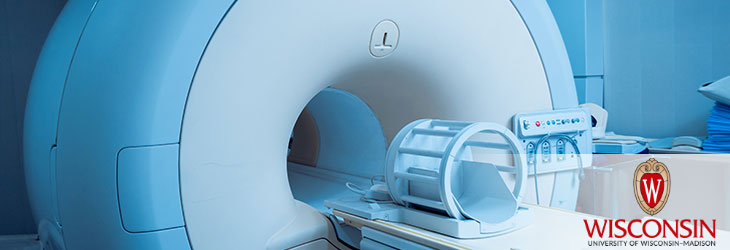Radiation Therapy

Controlled Radiation Therapy Delivery for Improved Cancer Cure Rate
WARF: P09326US02
Inventors: James Welsh
The Wisconsin Alumni Research Foundation (WARF) is seeking commercial partners interested in developing a treatment planning and delivery technique for biological modulation of external beam radiation therapy.
Overview
Conventional external beam radiation therapy is used for cancer treatment by irradiating a defined target region using beams of ionizing radiation. The purpose of a treatment plan is to accurately identify the target and localize the desired radiation to that target region in the patient. 3-D conformal radiation therapy (3D CRT) is an external beam radiation therapy technique that utilizes computer planning software to produce a 3-D radiation dose map specific to a target tumor. 3D CRT aims to minimize unwanted radiation dose to sensitive normal structures while still delivering a potentially curative dose to tumors. Intensity modulated radiation therapy (IMRT) also achieves this and goes a step further in the reduction of unwanted dose to normal tissues by allowing various regions to receive varying radiation dose intensities. Accurate geometric precision is required during treatment planning to increase the dose received by the tumor while decreasing the radiation dose received by surrounding healthy tissue. Image-guided radiation therapy (IGRT) employs medical imaging during radiation therapy to accurately direct radiation therapy using positional information and improves the potential of 3D CRT and IMRT to achieve their aims.
Despite these improvements in reducing the adverse biological effects of radiation treatment, concerns remain that high-dose treatments may be limited by the radiation tolerance of healthy tissue adjacent to the tumor. A need exists for a method of external beam radiation therapy that delivers high levels of radiation to a specific targeted region while simultaneously minimizing injury to healthy tissue and organs surrounding the target.
Despite these improvements in reducing the adverse biological effects of radiation treatment, concerns remain that high-dose treatments may be limited by the radiation tolerance of healthy tissue adjacent to the tumor. A need exists for a method of external beam radiation therapy that delivers high levels of radiation to a specific targeted region while simultaneously minimizing injury to healthy tissue and organs surrounding the target.
The Invention
UW–Madison researchers have developed a new treatment planning and delivery technique for external beam radiation therapy that minimizes the radiobiological effect on normal tissues while increasing the radiation dose to malignant tissue. The method uses computerized algorithms to determine an optimized sequence for radiation beams directed at the target to maximize the time between beams that also irradiate normal tissue. This temporal separation of radiation beams to normal structures maintains the maximal dose to the tumor target volume while minimizing the radiobiologically effective dose to healthy tissues surrounding the target. In principle, this reduces the normal tissue complication probability and chances of late radiation-related toxicity, and potentially increases the cancer cure rate by permitting higher total radiation doses to be prescribed and administered.
The steps to control radiation dose include obtaining an image of the subject, identifying the planned target region and the normal tissues adjacent to the target, and classifying each identified normal tissue. Then, a spatiotemporal dose-rate distribution is determined using a selected prescribed dose and information about the normal tissue and planned target region. By directing the radiation therapy system to irradiate the target according to the determined spatiotemporal dose-rate distribution, a selected dose-rate to the planned target volume is maintained while a lower effective dose-rate is received by the normal tissues.
The steps to control radiation dose include obtaining an image of the subject, identifying the planned target region and the normal tissues adjacent to the target, and classifying each identified normal tissue. Then, a spatiotemporal dose-rate distribution is determined using a selected prescribed dose and information about the normal tissue and planned target region. By directing the radiation therapy system to irradiate the target according to the determined spatiotemporal dose-rate distribution, a selected dose-rate to the planned target volume is maintained while a lower effective dose-rate is received by the normal tissues.
Applications
- Treatment planning for radiation therapy
Key Benefits
- Compatible with a variety of radiation therapy systems
- Permits maximal dose to be administered to planned target region
- Minimizes biological dose to healthy tissue surrounding the target
- Improves cancer cure rate while decreasing chances of radiation-related toxicity